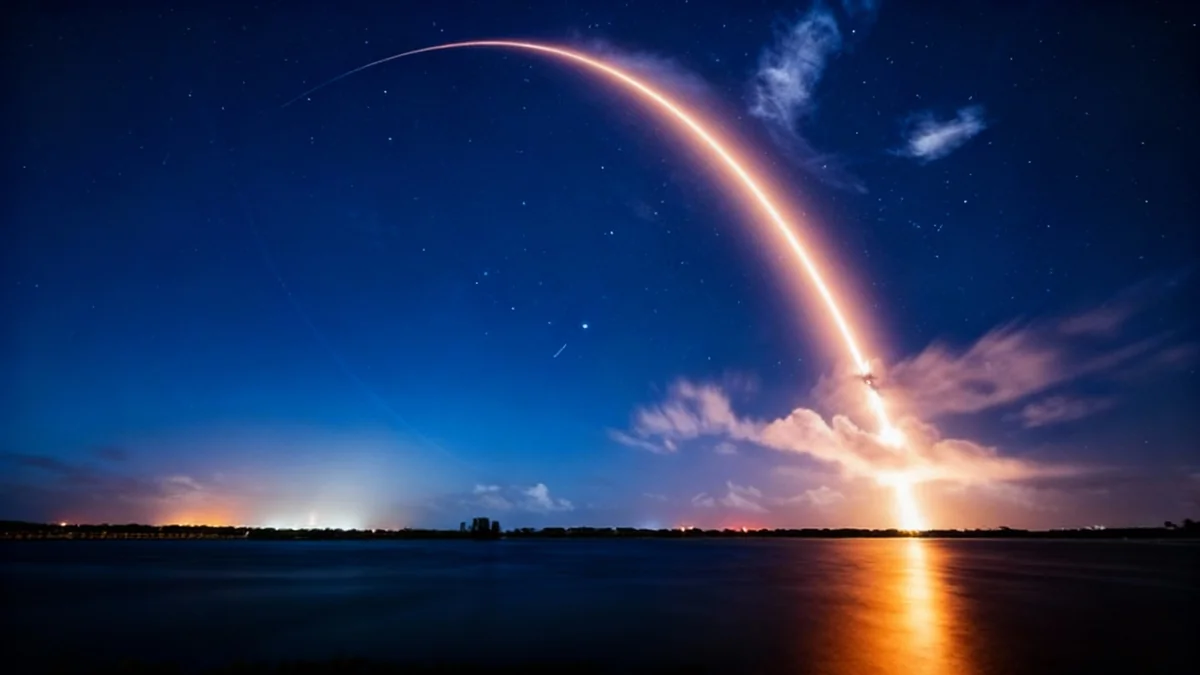SpaceX has crossed a significant threshold in its mission to build a global satellite internet network, launching its 10,000th Starlink satellite into orbit. The milestone was achieved on Sunday following a pair of successful Falcon 9 rocket launches from both Florida and California, which together added 56 new satellites to the growing constellation.
Key Takeaways
- SpaceX has now launched a total of 10,006 Starlink satellites since the program's inception.
- The milestone was reached during a launch from Vandenberg Space Force Base, California.
- Currently, 8,680 Starlink satellites are in orbit, with 7,448 in operational positions.
- SpaceX now operates an estimated 70% of all active satellites orbiting Earth.
- A Falcon 9 booster also completed its 31st flight, setting a new record for rocket reusability.
A Weekend of Records
Sunday was a busy day for SpaceX, with two Falcon 9 rockets launching just hours apart. The first mission lifted off from Florida's Space Coast, followed by a second from Vandenberg Space Force Base in California. Each rocket carried 28 Starlink satellites, but it was the West Coast launch that pushed the program past its five-digit milestone.
The moment was acknowledged during the live broadcast of the California launch. Just as the Falcon 9 rocket ascended, the launch director announced the achievement.
"From Tintin to 10,000. Go Starlink, go Falcon, go SpaceX."
This statement references the first two prototype satellites, named Tintin A and Tintin B, which were launched as pathfinders for the network back in 2018. The program has since evolved dramatically, with satellite designs becoming larger and more powerful.
About an hour after liftoff, SpaceX confirmed the successful deployment of the 28 satellites. They were released into an initial orbit approximately 160 miles (260 kilometers) above Earth. From there, the satellites were expected to deploy their solar arrays and use their onboard plasma engines to climb to their final operational altitude of 332 miles (535 kilometers).
From Prototypes to a Global Network
The Starlink project began with a different design in 2019, initially launching 60 smaller satellites per mission. As the satellites grew in size and capability, the number per launch decreased. The current V2 Mini generation of satellites can be launched 28 at a time, maximizing the Falcon 9's payload capacity.
The Scale of Starlink's Constellation
Reaching 10,000 launches is a headline figure, but the actual number of satellites currently in orbit is a more dynamic metric. SpaceX actively manages its fleet, de-orbiting older or obsolete satellites to make way for newer, more advanced models.
These retired satellites are designed to burn up completely upon reentering Earth's atmosphere, ensuring no debris reaches the ground. This constant refreshment means the number of active satellites is always changing.
According to data compiled by astrophysicist Jonathan McDowell, who tracks space launches and satellite deployments, the state of the Starlink fleet is extensive.
Starlink by the Numbers
- Total Launched: 10,006
- Total Satellites in Orbit: 8,680
- Functioning Satellites in Orbit: 8,664
- Satellites in Operational Orbit: 7,448
The numbers reveal a complex operation. While over 8,600 satellites are in space, a portion of those are still in the process of raising their orbits or undergoing testing before they become fully operational. The 7,448 satellites in their final positions are the ones currently providing internet service to a subscriber base that surpassed 7 million users in August.
An Unprecedented Orbital Presence
The size of the Starlink fleet is difficult to overstate. It is estimated that SpaceX now owns and operates up to 70 percent of all functioning satellites currently in orbit. While the exact total number of active satellites from all operators is hard to pinpoint, the European Space Agency estimates the figure to be around 12,500.
This dominance highlights the rapid pace of SpaceX's launch schedule and its mass-production approach to satellite manufacturing. The current V2 Mini satellites feature large solar arrays that span 100 feet (30 meters) from tip to tip, making them powerful but also large.
The company is already planning for the next generation, known as V3. These satellites will be too large to launch on the Falcon 9 and will require the company's new, much larger Starship rocket. A single Starship mission is expected to carry around 60 of these V3 satellites at a time, potentially accelerating the network's expansion even further.
Falcon 9 Continues to Break Barriers
Beyond the Starlink milestone, Sunday's launches also marked a new achievement for SpaceX's workhorse rocket, the Falcon 9. The booster used for the Florida launch completed its 31st successful mission, a record for the company. After deploying its payload, the rocket landed on a recovery ship in the Atlantic Ocean and will be refurbished for a 32nd flight.
SpaceX has several other boosters in its fleet that are approaching their 30th launch. The company's engineers are now certifying the Falcon 9 for up to 40 flights each, pushing the boundaries of rocket reusability.
The pace of launches in 2025 is also on track to set a new record. With these two missions, SpaceX has now conducted 132 Falcon 9 flights this year, tying its total from all of last year. Including two Falcon Heavy launches, the company's total for the year stands at 134 missions by the Falcon family of rockets.
With more launches scheduled for the coming week, SpaceX is poised to break its own annual launch record, demonstrating a cadence that no other company or country has been able to match.





